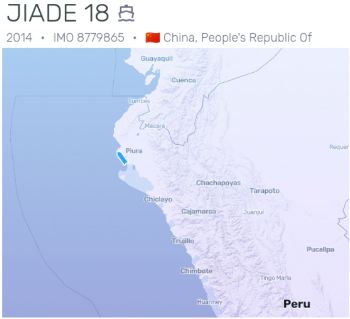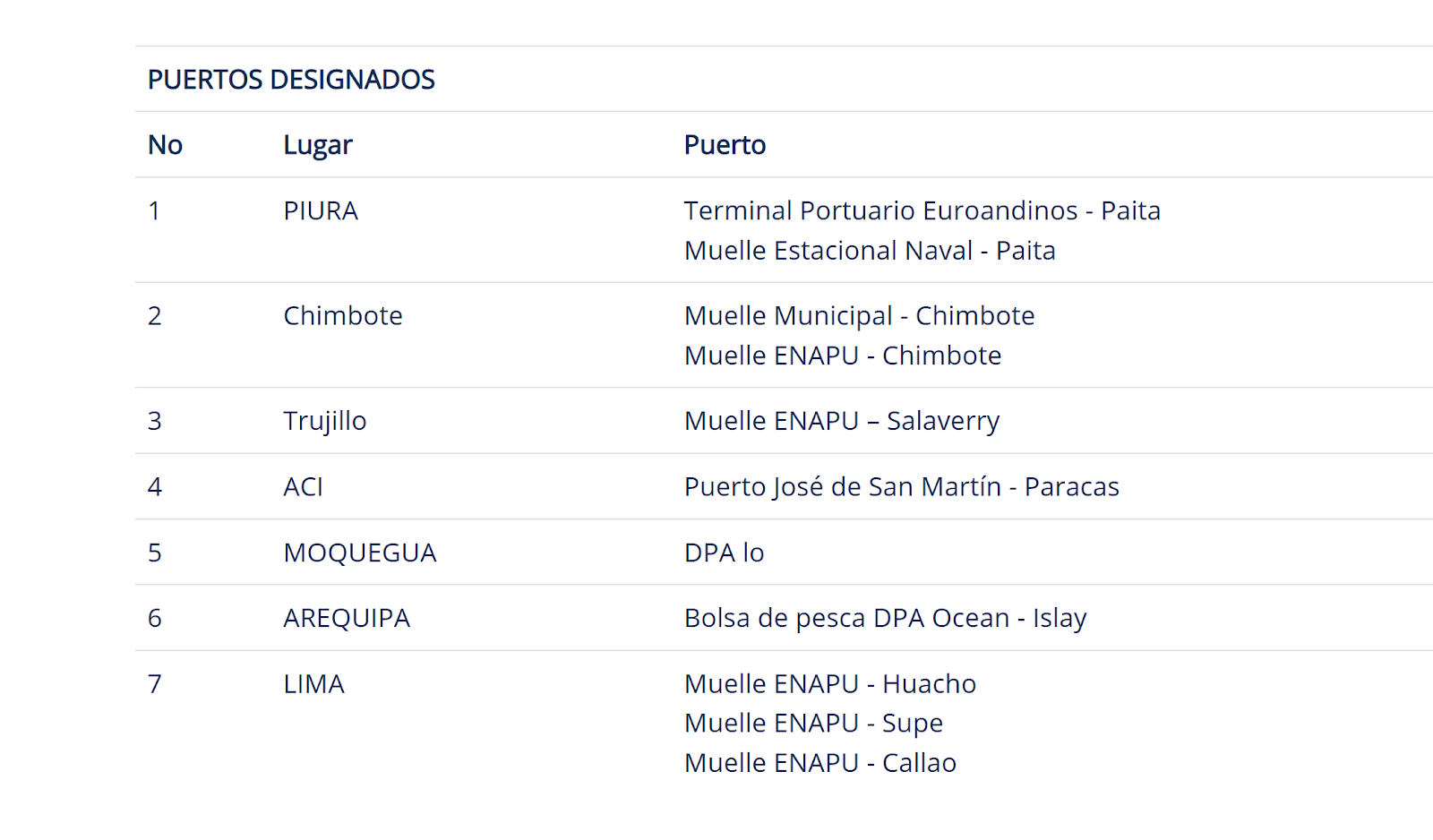|

Photo: shiptraffic.net
They warn of the presence of Chinese fishing boats in a prohibited area within Peru
 PERU
PERU
Sunday, July 14, 2024, 14:00 (GMT + 9)
On the morning of Saturday the 13th, Sechura Bay woke up to an unusual surprise: two imposing fishing boats flying the Chinese flag woke up anchored very close to the port of Bayóvar.
The steel giants, identified as JiaDe18 and Hai Feng 1, with holds of 965 and 488 tons respectively, have remained on extensive fishing days. The first has been at sea for approximately six months, while the second has been operating for almost a year, according to the records of Starboard Marine Intelligence, a platform that tracks the position of these ships in real time using satellite data from the collision avoidance system. AIS that these ships have.
This unexpected sighting becomes relevant because, according to the institution that regulates its activity in the region (i.e., the South Pacific Regional Fisheries Management Organization, RFMO-PS), the Port of Bayóvar is not authorized to receive foreign flag vessels. that fish for squid on the high seas, such as the ports of Paita, Chimbote, Trujillo, Paracas, among others.

Fig 1. Ports designated by the Peruvian state before the PSRFMO to receive foreign fleets that fish for squid on the high seas (Source: PSRFMO official website)
Alfonso Miranda, president of CALAMASUR, stressed that this is an unprecedented event and represents a failure to comply with Peru's commitments within the framework of Conservation and Management Measure CMM 07 of the SPRFMO and the Agreement on Measures of the Governing State of the Port. “The entry of foreign vessels that operate in waters managed by the PSRFMO to a port not designated for such purposes could even lead to a potential absence of inspections of these vessels. A fact that violates international standards and agreements established to prevent illegal, unreported and unregulated (IUU) fishing. "This type of negligence compromises the integrity of global efforts for the sustainability of fisheries and the application of Port State Measures, essential to combat IUU fishing and protect marine resources."
The first appearance of these colossi in the port of Bayóvar and the prompt arrival of three other ships to this same port, has set off alarms among the main actors in the fishing sector. According to the arrival and departure schedule of the Bayóvar Port Authority obtained through the REDENAVES platform, three more ships from China are expected to arrive at the port in the next few hours. These would be Pu Yuan 777, Huan Yi 788 and Jin Hai 829.
.png)
Fig. 2. Schedule of arrivals and departures to the port of Bayovar between 07/11 and 07/20, 2024 (Source: National Port Authority) | Click image to enlarge it
"It is regrettable to see how after the recent announcement by the Minister of Production about the strengthening of satellite controls for foreign vessels, the arrival of these vessels has intensified, which have taken advantage of the lax interpretation of the previous PRODUCE management to enter without a adequate control of Peruvian ports. Furthermore, it is regrettable how the commitments that Peru has signed in international forums have been breached. These have been the basis for the country being considered an example in the region in the fight against fishing. illegal. We ask the current minister, Sergio Gonzales, to take action with the speed it deserves," Henry Juarez, president of the Association of Artisanal Fishermen dedicated to the extraction of squid, mahi mahi, and others Parachique – La Bocana (APADEXPO) and current secretary of the National Artisanal Fishing Society (SONAPESCAL).
It should be noted that Gonzalez, who heads the portfolio of the Ministry of Production, recently attended the 36th session of the Committee on Fisheries (COFI), an event organized by the FAO. At this meeting, the international community demanded improvements in giant squid management and greater transparency from China's distant water fleet. Likewise, it should be noted that Minister Sergio González announced less than a month ago the publication of a supreme decree to guarantee the enforceability of the use of Peruvian satellite tracking for any foreign squid vessel that attempted to use Peruvian port facilities. However, while the announced regulations sleep the sleep of the just, more than 80 Chinese ships are already entering Peru with all kinds of questions.
.png)
Fig. 3. Trajectory of the Hai Feng 1 ship entering Peru, interlined images represent AIS shutdown events (Source: Starboard Marine Intelligence) | Click image to enlarge it
For example, of the vessels identified, the Hai Feng I shows high signs of illegal fishing. According to Starboard Marine Intelligence, in the last 60 days, the Hai Feng I reportedly turned off its AIS collision avoidance system for almost 10 days. Furthermore, during her entry into Peru, this ship would have turned off the AIS on more than two occasions, accumulating more than 24 hours without sending a signal within the national territory. It should be noted that this ship entered before JiaDe18; However, for unknown reasons, it has been traveling at a slower speed than its companion and has scheduled its arrival in Bayóvar 12 hours later.
On the other hand, it is important to mention that on July 12, the Chinese ship Pu Yuan 818 arrived in Chimbote, a ship that in the last 6 months has turned off its AIS anti-collision equipment for almost 10 days. In addition, there are indications that she would have also turned off the AIS for 2 days between June 11 and 13, very close to 200 miles and in front of Chimbote.
.png)
Fig 4 Trajectory of the Pu Yuan 818 ship off 200 miles from Peru, the interlined images represent AIS shutdown events and the interlined circles represent possible encounters (Source: Starboard Marine Intelligence) | Click image to enlarge it
Finally, it is crucial to note that turning off the AIS collision avoidance system is not only an indicator of possible illegal activities, but also puts the safety of the entire crew at risk. When it stops emitting a signal, the ship disappears from the tracking system, increasing the risk of collisions with other ships. This danger is not theoretical; There have been documented cases of ship-to-ship collisions due to AIS being turned off by one of the vessels. This irresponsible practice not only challenges legality, but also compromises integrity and safety at sea, underscoring the need for stricter surveillance and severe sanctions for those who violate these rules.
[email protected]
www.seafood.media
|



